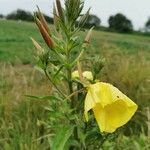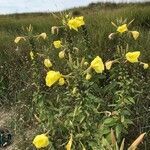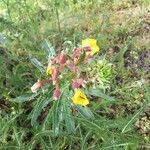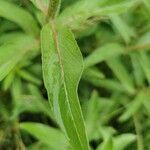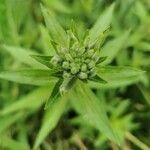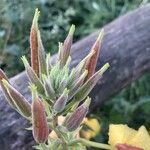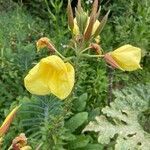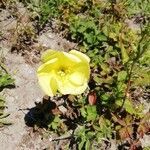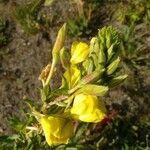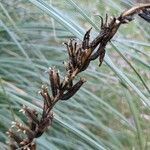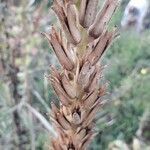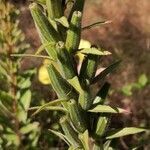Hairy biennial, taprooted herb. Stems to c. 1.5 m tall, branched, with dense short curly hairs, and scattered to numerous, long, dark red, bulbous-based hairs. Rosette lvs numerous, long-petiolate; petiole to 10 cm long; lamina mostly 7-25 × 2-7 cm, narrow-to broad-elliptic, sometimes ± obovate, with appressed hairs or glabrate; margins almost entire to denticulate, sinuate, ciliolate; base attenuate; apex acute. Cauline lvs, excluding uppermost, with petiole to 3 cm long and lamina usually more slender and tapering than in rosette lvs. Infl. spike often dense, simple or branched, with hairs as on stems. Fls crepuscular. Floral tube 2.5-4.5 cm long, with glandular and scattered pilose hairs, viscid, slender. Buds lanceolate, ± erect. Sepals 3.5-5 cm long, linear-lanceolate, ± reddish, with hairs as on hypanthium; apices mucronate, 5-10 mm long. Petals (3)-4-5.5 cm long, broad-obovate, bright or lemon yellow. Style exserted by 2.5-4 cm. Capsule (1.2)-1.7-2.5-(3) cm long, cylindric, widening slightly towards base, ribbed, mostly viscid but rarely eglandular. Seeds usually 1.5-2.2 mm long, often irregular, but sometimes ± oblong or lunate, sharply angled.
Short-lived perennial or biennial to c. 1.5 m high. Stems 1 to several, robust, simple or branched, with stiff hairs, many with a broad, red base, also with short, appressed and glandular hairs in upper parts. Basal leaves rosetted, usually lanceolate to oblanceolate, to c. 30 cm long and 5 cm wide, acute or obtuse; cauline leaves denser, to c. 15 cm long and decreasing in size up the stem, undulate, usually acute and sinuately denticulate. Flowers in dense, mostly simple spikes. Hypanthium 3.5–5 cm long. Sepals 2.8–4.5 cm long, often reddish. Petals 3.5–5 cm long, yellow, ageing reddish. Capsule sessile, somewhat oblong but broader towards base, 2–3 cm long, 5–6 mm wide, with spreading hairs.
Bushy biennial, short-lived perennial, 0.8-1.2 m high; forming rosettes; stems crisp puberulent, many hairs arising from red papillae. Cauline leaves broadly lanceolate, crinkled, base cuneate, apex ± acute; petioles 0-20 mm long. Floral tube up to 50 mm long. Sepals with free tips 5-8 mm long. Petals up to 50 mm long. Flowering time Dec.-May. Fruit a capsule, up to 30 x 6 mm. Seeds 1.3-1.7 mm.
Biennial or short-lived perennial herb, 0.8-1.2 m high. Stems erect; conspicuously muricate with red bulbous bases on longer hairs. Leaves petiolate; blade ovate to ovate-oblong, 50100 x 25-40 mm, margins strongly crinkled. Flowers: floral tube 35-50 mm long; sepals 20-60 mm long, petals 35-50 mm long, golden-yellow, fading red-orange; Nov.-Apr. Fruit cylindrical, 20-25 mm long.
Much like O. biennis var. biennis, but with broader cauline lvs and larger fls, the sep 2–6 cm, with tips 5–8 mm, the pet 3–5 cm, the styles 2–6 cm; 2n=14, a complex heterozygote. Cultigen, widely but sparingly escaped. (O. erythrosepala; O. lamarckiana, misapplied)
A herb which takes 2 years to complete its life cycle. It grows 0.9-1.5 m high and spreads 40-60 cm wide. The leaves are broadly sword shaped and in a ring near the base. They are finely hairy. The flower heads are bright yellow. The sepals are red.
Stems conspicuously muricate with red bulbous bases to the longer hairs. Leaves strongly crinkled. Petals 30-60 mm long. Sepals 20-60 mm long. Capsule cylindrical. Flowers golden yellow, fading red-orange.
